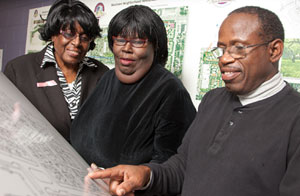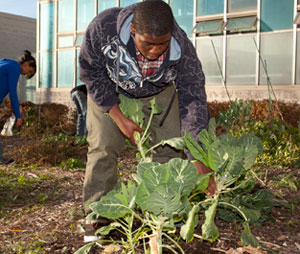
Paulette Bangura’s interest in improving the environment in her neighborhood is very personal. Five years ago she had a double lung transplant after life-threatening complications from sarcoidosis, an immune disease that may be triggered by environmental factors.
Today she’s active in a pioneering environmental collaboration in Westlawn neighborhood started by the University of Wisconsin-Milwaukee’s College of Nursing.
As she fought her way back from near death, Bangura decided she would work to improve the environment in her community for herself and others. “I wanted to be involved in issues of environmental justice and health, share my insights and support what they’re doing with the Westlawn Project.”
The Westlawn Project is a unique environmental improvement effort involving the College of Nursing, the Environmental Protection Agency (EPA), 26 Westlawn-area organizations and local residents. They are all working together, in a collaboration that is cited as a “win-win” template for community partnerships, promoting wellness and reducing exposure to environmental toxins.

The EPA’s Community Action for a Renewed Environment (CARE) program provides support for the project, which started in 2008. In November, the College of Nursing received additional funding of nearly $300,000, one of only three partnerships in the country to receive a second round of funding.
Asthma, advocacy on the rise
Westlawn, centered around the Silver Spring Neighborhood Center at 64th and Silver Spring, is home to the largest publicly funded housing project in the state, and residents there face significant health challenges related to environmental issues, according to Anne Dressel of UWM’s College of Nursing.Dressel acts as project manager and principal investigator.
The rate of emergency room visits for asthma within Westlawn’s 53218 ZIP code is four times that of other areas of the state, and the rate of hospitalization is more than three times that of the rest of the state, according to Dressel.
“EPA is proud to support this ambitious project to improve community health,” says Susan Hedman, director of the EPA’s regional office. “The agency has committed nearly $400,000 (in total) to help make homes and day care centers in Westlawn healthier for children, especially those who suffer from asthma.”
Bangura, a native of Ghana, teaches participatory research techniques and other courses at UWM’s School of Continuing Education. She’s pleased, she says, that CARE is reaching out to the African and Hmong immigrant populations in the area, as well as those who live in the Westlawn housing project.
The UWM Silver Spring Community Nursing Center, which offers primary and preventive healthcare and nursing education, has long had a strong presence in the neighborhood and earned the trust of residents, says Betty Koepsel, project coordinator. The Westlawn Project “offered great opportunities to address environmental health and associated health disparities holistically within this community we serve.” .

In addition to asthma-related issues, community residents worked with Dressel and Koepsel to identify other issues impacting their environment. Lack of access to fresh, healthy food; mold; poor indoor air quality; and pest management were among the top concerns.
Stories of success
In the past two years, CARE has achieved a number of successes in addressing these problems, says Dressel. To address air-quality issues, the Housing Authority of the City of Milwaukee (HACM) will include asthma-friendly housing in the Westlawn Housing Redevelopment now under way. Maria Rodriguez and Ken Barbeau of the housing authority are active members of the Westlawn partnership.
Both residents of the nearby neighborhoods, like Bangura, and residents living in the Westlawn Housing Project say the CARE partnership has been vital in educating people about environmental issues.
“I’ve learned a lot about what to do to help reduce substances in the environment that affect my son’s asthma,” says Sally Nickerson, a resident who now serves as a community ambassador for the project. She changed the cleaning products she uses, and notes, “Now people are coming to me with questions about ways they can improve the environment in their homes.” Nickerson says she always wanted to be a teacher or a nurse, and her role with the project is fulfilling that dream by letting her teach people how to take care of their health and the environment. And, CARE’s collaborative approach has helped focus attention on the environmental aspects of projects already under way.
A healthier future
“It helped us fit all the pieces of the puzzle together,” says Ellene Parks, head of the Westlawn Resident Council, which has worked closely with the housing authority and the CARE project in including environmental concerns as part of the planning for new housing now under construction. HACM is developing mold-abatement programs, adding green space and trees, and making room for community gardens as area housing is redeveloped. The partnership has also added members like Growing Power and Milwaukee’s Asian Market to help link residents with sources of fresh fruit and vegetables.
The partnership also works closely with UWM nurses and nursing students at the Silver Spring Community Nursing Center to promote health and wellness through education and preventive care. Nursing students and Milwaukee Public Schools (MPS) nurses collaborate on an asthma awareness program called “Asthma Smarts” and are teaching hands-on environmental science at the Silver Spring Neighborhood Center’s Community Learning Centers.
CARE partners also worked with police to reduce speeding in the neighborhood, and with MPS to get “no smoking” signs placed outside the Silver Spring Neighborhood Center, where smokers once congregated. Browning Elementary School is housed in the building, and secondhand smoke can aggravate asthma symptoms.
Residents are excited that CARE has received additional funding to continue work on environmental projects in the neighborhood. “It’s important that we make more people aware of how to live healthier lifestyles,” says Gracie Leonard, a longtime resident and volunteer who’s a member of the project’s planning board. “I would like to see more good things happening out here.”
(PHOTOS)
Front page photo rotation:
Project Leaders:
Westlawn project leaders Anne Dressel (center) and Betty Koepsel (right) of UWM’s College of Nursing with Pai Yang (left) at the Milwaukee Asian Market. Yang is the owner of the market, which is a business partner in the Westlawn project. Access to fresh produce is a concern of Westlawn residents.
Photo by Troye Fox
Residents:
Westlawn residents Ellene Parks, (center) head of the resident council, and Gracie Leonard (left), a resident and member of the project’s board, look over the plans for new Westlawn housing with Larry Moore (right), Milwaukee housing authority liaison to residents.
Photo by Alan Magayne-Roshak.
Garden:
The project’s community ambassador, Sally Nickerson (in blue at center), works with students and a representative from Growing Power (at left) in harvesting the last produce from a garden behind Browning School. Growing Power is a partner in the Westlawn project, and working with MPS and other partners in educating young people about the environment and healthy eating are part of the project’s mission.
Photo by Alan Magayne-Roshak.






